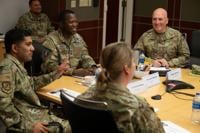Thousands of Space Force guardians have traded out fitness tests for continuous tracking of their workouts.
The two-year study expected to wrap up in 2025 has attracted about 7,500 guardians, nearly 80% of the force, with most of those participants in Colorado, explained Adam Strang, a psychologist with the Air Force Research Laboratory’s 711th Human Performance Wing. Colorado is home to most guardians, with the rest scattered in smaller pockets at bases around the United States.
The study has been “overwhelmingly popular” and offers far more freedom to guardians, who otherwise would have to be focused on running, push-ups and sit-ups to pass fitness tests.
The other service branches all have similar fitness tests with different events based on job requirements — sailors need to swim and soldiers must complete a standing power throw.
Guardians in the study strap on Garmin watches and commit to an average of 150 minutes of intense physical activity a week, Strang said. The requirement ensures that guardians aren’t cramming for physical assessments.
Working out consistently could help reduce the risk of injury that comes along with rapidly intensifying workouts. While researchers have never focused on whether military service members put off working out until their fitness tests approach, most guardians self-reported they crammed ahead of tests, Strang said.
With constant tracking guardians can be held to the same physical standards, while participating in activities that appeal to them.
“We have got people who can get their exercise from jiu-jitsu, from dance, from hiking,” said Alex Morrow, with the guardian resilience team at Peterson Space Force Base. Even playing with kids can qualify if guardians reach the right level of cardio intensity, he said.
The data can give guardians a nudge if they are falling behind, or a bit of a mental reward if they are ahead.
It also allows members of the guardian resilience team to see exactly how participants are exercising rather than relying on conversations, which may or may not be accurate.
The tracking has allowed members of the guardian resilience team to intervene if they see a particular person is having trouble based on the data, even if they have not come into the office for help, Morrow said. The teams focus on holistic wellness, including mental health and spiritual wellness, Morrow said.
“We can see day to day, week to week if they are doing it and if it is working for them or if we need to make some kind of adjustment,” Morrow said.
If participants had to go back to the Air Force’s traditional fitness tests on short notice, they would have no problem with it, he said.
The coaching is similar to what college or professional teams would receive, Strang said, and can help guardians balance big life changes, such as moving from one base to another while maintaining their workout routine.
For purposes of the study, data from individuals is de-identified using a code or alias, he said, and only data that will answer the research questions is used.
At the heart of the work is the critical comparison with the status quo.
“Is what we are doing equal to or better than what we already got and that is a fundamental sort of experimental question we need to handle in this study, at least in respect to cardiorespiratory fitness,” Strang said.
The researchers are looking to airmen with similar job requirements to the Space Force to provide that comparison and determine whether continuous fitness tracking should replace testing.
The results of the study, expected at the end of October, will help drive that decision for the Space Force and potentially for other military branches, such as the Air Force.
While wearable fitness trackers are a hot topic for the military, the Space Force has been able to move fast to explore them because the branch is so much smaller than the rest.
“They want to do their best from a scientific and a technical perspective of getting it right,” he said.












